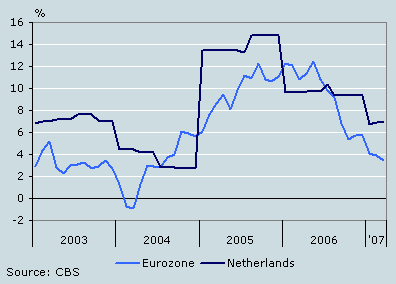Dutch inflation no longer below eurozone average

Dutch inflation equalled the average in the eurozone in March 2007. This is the first time since September 2003 that it has not been below the eurozone average.
Inflation in the Netherlands and the eurozone

Supermarket price war tempers Dutch inflation
There are three certain explanations of the strong increase in Dutch inflation. Since the end of 2003 the relatively low inflation in the Netherlands was to an important extent the result of the supermarket price war. Price developments of supermarket items such as food, soft drinks, beer and detergents were much more favourable than in the eurozone. The price war more or less ended in the course of 2006.
Inflation food and soft drinks

Delayed effect of energy prices
Changes in global energy prices are always passed on to consumers in the Netherlands with some delay in the prices of natural gas and electricity. This resulted in a slower fall in inflation in the Netherlands in the autumn of 2006 compared with the eurozone.
Inflation gas and electricity

Clothes prices close the gap with Europe
The strong increase in inflation in the Netherlands in March 2007 was largely caused by developments in prices of clothes and shoes. These cost 4.4 percent more in March than twelve months previously. This is a clear deviation from the average in the eurozone.
Inflation clothes and shoes

Inflation similar in eurozone countries
The differences between inflation in the eurozone countries were small in March. Inflation was lowest in France, at 1.2 percent. Furthermore inflation is only below the European average in Belgium and Finland. In Austria it equalled the eurozone average, just as in the Netherlands. Greece and Ireland had the highest rates of inflation.
Inflation according to the harmonised consumer price index, March 2007

Jan Walschots